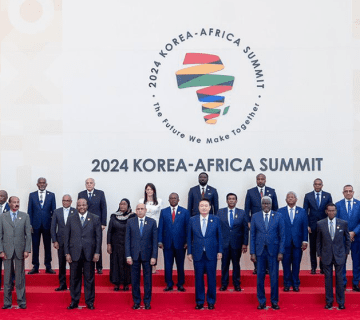Kenya is currently facing a large-scale, climate-change-induced humanitarian crisis, and the most vulnerable segment of population is women. While it is ranked among the least contributors to greenhouse gas emissions, climatic fluctuations have had a significant impact on women in Kenyan society. The failure of the fifth consecutive rainy season in the country, which has also been followed by flooding in some areas, has made the situation, especially in the semi-arid and arid lands (ASAL) of Kenya, direr. In a report released by the Danish Refugee Council (DRC), on drought-affected populations, the counties in the Northern part of the country have been identified as the most affected by this calamity. These counties include Mandera, Turkana, Marsabit, and Isiolo.
The United Nations Population Fund in March 2023 highlighted that the majority of those displaced due to the brutal drought in these counties are women and children. Most of them have taken refuge in overcrowded, unsanitary, and unsafe camps after undertaking perilous journeys in search of food and water. The National Drought Management Authority (NDMA) estimated in October 2022 that of the four million people who were grappling with acute hunger in drought-affected areas in Kenya, 134,000 were women who were either pregnant or breastfeeding.
How is climate change affecting women in northern Kenya?
The drought that has plagued the country for the last five years has exposed the vulnerability of Kenya’s socio-economic systems to shocks from climate change, and unfortunately, women have been adversely affected more than their male counterparts.
In Kenya, an estimated 4.1 million women live under the standard poverty line of $1.90 per day, outnumbering men in similar conditions. Women in the poverty-stricken counties of Isiolo, Mandera, and Turkana in Northern Kenya are particularly vulnerable, as these counties have been identified as some of the poorest in the country. Harsh climatic conditions have only amplified this situation. For instance, settlements have become temporary and people are dependent on the available water and pasture for livelihoods. This has led to an increase in the number of internally displaced women in the country, exacerbating their plight.
The rate of teenage pregnancies has also spiked in the region, as reports show that young girls are being forced into transactional sex in order to pay for food. Others have been forced out of school and married off so that families have one less mouth to feed and can secure a bride price to help support the rest of the family. This is a result of the dependency on predictable and steady rainfall for agricultural and pastoral purposes among communities in the northern part of Kenya. In October 2022, it was estimated that the county of Mandera alone had lost over Ksh. 11 billion in monetary value, due to the death of livestock caused by the drought. Substantive crop production in the ASAL has also diminished at an alarming rate over the last six years, and this is a situation is expected to deteriorate in the absence of any intervention.
Traditionally, in arid areas such as Turkana County, it has been the women’s duty to go out in search of water. Women and girls are now being forced to travel great distances to look for water for domestic consumption. This has greatly affected girls’ access to education as they are being kept out of school in order to search for water. There has also been a noted increase in the levels of gender-based violence and general insecurity. A study by the Danish Refugee Council reported in October 2022 that 82 per cent of women interviewed felt unsafe in their communities, due to lifestyle changes linked to the drought. As a case in point, women often have to travel long distances to find water and are at risk of experiencing gender-based violence, not only from members of other communities but also from members of their own communities who are also trying to secure water.
The northern region of Kenya has also seen a significant increase in health risks for women and girls. The severity of the drought has disrupted access to critical health services as women for go essentials such as menstrual hygiene products and general hygiene products such as soap to secure food instead. Forced migration due to the drought has also moved families away from health facilities, in November 2022, it was estimated that the number of births supported by health facilities in Kenya had dropped from 411 births per month to 100 per month. A rate that is predicted to continue dropping. The cases of Female Genital Mutilation (FGM) have also spiked.
What can be done to help these women?
Gender inequalities in Kenya have been amplified by stressors of climate change. It is crucial that humanitarian responses to climate related calamities such as drought, mainstream issues on gender, age, and diversity to assist and protect women, children, as well as the elderly. This should be done alongside aggressive campaigns that continue to highlight why women and girls need to be protected in times of crises. Engaging in projects such as the creation of accessible and safe water points in such areas can be a good start. Additionally, climate mitigation must be prioritised by the government. The National Climate Change Action Plan provides a comprehensive framework that can immensely help Kenya, however, a lack of clear climate policies and how they will be implemented diminishes its impact. Kenya’s drought response is underfunded. International crises like COVID-19 and the Russia-Ukraine Conflict have had massive impacts on the socioeconomic state of the world and Kenya. Thus, the country will need prioritization of increased financing to implement effective measures to help vulnerable communities against the vagaries of climate induced disasters.
Raudhat Sadam is a Researcher at the HORN Institute
In Kula Mawe, Isiolo County, a woman is filling up a barrel at a water point. (Photo Credit: Obi Anyadike)
The contents of this article are copyright of © The HORN Institute 2022. All rights reserved. Any redistribution or reproduction of part or all of the contents in any form and for whatever reason is prohibited. You may use the content of this article for personal reasons, but acknowledge the author and cite the website as sources of the material.



